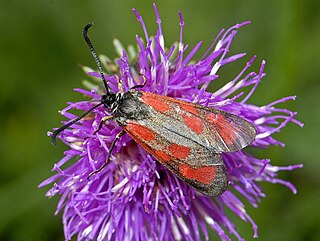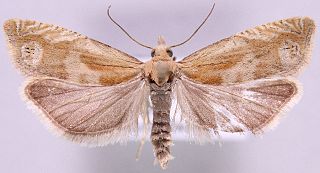
Zygaena loti, the slender Scotch burnet, is a moth of the family Zygaenidae. It is a diurnal moth characterized by a black body, light colored legs, and red spots on its wings. The caterpillars are a yellow-green color and usually molt out of dormancy in late February to early March. The larvae feed on plants from the family Fabaceae until they enter their pupal stage and mature into adults in May to early June. For mating, Zygaenidae exhibit a dual-partner finding strategy, where females use pheromones while assuming a calling position, and males exhibit a patrolling behavior where they utilize both vision and the olfactory receptors in their antennae to locate a potential mate.
Jordanita hispanica is a moth of the family Zygaenidae. It is found in Spain, Portugal and southern France.

Jordanita budensis is a moth of the family Zygaenidae. It is found in disjunct populations in central Spain, southern France, Italy, eastern Austria, Hungary, the Balkan Peninsula, Greece, Ukraine, the Crimea, the European part of southern Russia, the Caucasus, Transcaucasia, Turkey, southern Siberia, Mongolia and the Amur region.
Jordanita notata is a moth of the family Zygaenidae. It is found from the Iberian Peninsula and central Europe, through the northern part of the Mediterranean region to the Caucasus and Transcaucasia.
Jordanita paupera is a moth of the family Zygaenidae. It is known from Turkey, Transcaucasia, Jordan, northern Iran, Turkmenistan, Uzbekistan and Kazakhstan. In the east, it ranges up to the Amur and Korea.
Jordanita volgensis is a moth of the family Zygaenidae. It is known from eastern Ukraine, southern Russia, Transcaucasia, Turkey and Syria.
Jordanita hector is a moth of the family Zygaenidae. It is known from southern Turkey and Lebanon.
Jordanita algirica is a moth of the family Zygaenidae. It is found in Morocco, Algeria and Tunisia. There are also some unconfirmed records from Sicily.
Jordanita rungsi is a moth of the family Zygaenidae. It is found in the central areas of the Middle Atlas in Morocco.
Jordanita carolae is a moth of the family Zygaenidae. It is found in the south-eastern High Atlas in Morocco at altitudes between 1,000 and 1,500 meters.
Jordanita minutissima is a moth of the family Zygaenidae. It is found in the Saharan Atlas and the Aurès Mountains.
Jordanita benderi is a moth of the family Zygaenidae. It is found in the High Atlas in Morocco.
Jordanita maroccana is a moth of the family Zygaenidae. It is found in the Middle Atlas in Morocco. It is found at altitudes of up to 2,000 meters.

Jordanita chloros is a moth of the family Zygaenidae.

Jordanita globulariae, also known as the scarce forester, is a day-flying moth of the family Zygaenidae.
Jordanita graeca is a moth of the family Zygaenidae. It is found from southern Slovakia through Hungary, the Balkan Peninsula, Rhodes and Cyprus to southern Russia, Ukraine, Transcaucasia, Turkey, Iran and northern Iraq.
Jordanita subsolana is a moth of the family Zygaenidae. It is found from southern Spain though the southern part of central Europe, Italy, the Balkan Peninsula and Greece to southern Russia and Ukraine, Turkey and Transcaucasia up to the Altai.
Jordanita anatolica is a moth of the family Zygaenidae. It is found in Nakhchivan, southern Turkey, Cyprus, Syria, Lebanon, Israel, Jordan, Egypt and north-eastern Libya. In the east, the range extends to Iraq and Iran.

Zygaena cynarae is a species of moth in the Zygaenidae family. It is found from France east to Russia.

Eucosma hohenwartiana, the bright bell, is a species of moth of the family Tortricidae. It is found in China, Central Asia, North Africa and Europe, where it has been recorded from Sardinia, Sicily, Ireland, Great Britain, Spain, France, Germany, the Benelux, Denmark, Austria, Switzerland, Italy, the Czech Republic, Slovakia, Slovenia, Hungary, Poland, Romania, Bosnia and Herzegovina, Norway, Sweden, Finland, the Baltic region and Russia. The habitat consists of dry open areas and grassland.






